 |
|
Reykjavík Airport (Icelandic: Reykjavíkurflugvöllur, (IATA: RKV, ICAO: BIRK) is the main domestic airport serving Reykjavík, the capital of Iceland, located about 2 kilometres (1.2 mi) from the city centre. Having shorter runways than the city’s bigger Keflavík International Airport, which is sited 50 kilometres (31 mi) out of town, it only serves internal flights within Iceland and to Greenland, small international charters, transatlantic ferry flights and private flights. It can also serve as alternate airport for flights inbound towards Keflavík, in case of adverse weather conditions there. To distinguish from Keflavík International Airport outside Reykjavík, it is sometimes unofficially called Reykjavik City Airport, and also Reykjavik Domestic Airport, but also Reykjavík international Airport because it has some international flights but mostly domestic ones.
Reykjavík Airport is the main hub of Air Iceland Connect and Eagle Air. Of the airport’s three runways, two are currently active all-year round. The shortest runway, 06/24, is usually used only in winter, and takeoffs from 06 (northeast direction) are forbidden because of safety and noise. Reykjavík Airport is owned and operated by the state enterprise Isavia.
|
Reykjavík Airport
Reykjavíkurflugvöllur
|
|
|
|
|
| Summary |
| Airport type |
Public |
| Owner |
Isavia |
| Serves |
Reykjavík, Iceland |
| Elevation AMSL |
44 ft / 14 m |
| Coordinates |
64°07′48″N
021°56′26″W |
| Website |
isavia.is |
| Map |
Location of Airport in Iceland
|
| Runways |
| Direction |
Length |
Surface |
| m |
ft |
| 01/19 |
1,566 |
5,140 |
Asphalt |
| 06/24 |
960 |
3,150 |
Asphalt |
| 13/31 |
1,230 |
4,034 |
Asphalt |
|
| Statistics |
| Passengers (2016) |
417,309 |
| Aircraft Movements (2011) |
54,038 |
|
History
Hawker Hurricane aircraft at RAF Reykjavik during World War II
The first flight from the airport area was 3 September 1919, with the takeoff of an Avro 504, the first aeroplane in Iceland. Until 1937 there were experiments with airline operations in Vatnsmýri, but with the foundation of Iceland’s oldest airline, Flugfélag Akureyrar (now Icelandair) in Akureyri in 1938, operations began in the area and in March 1940 scheduled flights started when Flugfélag Akureyrar moved its hub from Akureyri to Reykjavík (and changed its name to Flugfélag Íslands).
The current airport was built by the British Army during World War II on the south coast of the Reykjavík peninsula. Construction began in October 1940, when the airport had only a grass surface. The Black Watch regiment built the first runway, constructing it over sunken oil barrels. The British Royal Air Force operated from the airport, then named RAF Reykjavik, from March 1941. On 6 July 1946 the British handed the airport operation over to the Icelandic government and since then it has been operated by the Icelandic Civil Aviation Authority (now Flugstoðir).
Renovation of the airport started in 2000 and lasted two years. This was followed by a referendum in 2001, with 49.3% of the votes for moving the airport out of the city centre, and 48.1% votes for it remaining in place until 2016, when the current urban plan expires. The outcome of these elections on the other hand was not binding because election participation was under 40% and the left wing majority made the decision to have such a clause for it to be binding and beyond that because these elections were not held properly in respect to certain legal technicalities that also resulted in no option for non-election day voting (for vacationers for example).
After renovation, the width of runways 01/19 and 13/31 are 45 m and 06/24 is 30m, with visual approach for runways 01 and 31, while runway 19 has ILS CAT I/NBD-DME approach and runway 13 has LLZ-DME/NDB-DME approach. The lights for the runways were updated with LIH Wedge for all runways.
Future
The city has grown around the airport and it is now located in the western part of the city. This location is considered inconvenient by many, for noise and safety reasons and because it takes up a lot of high market-value area near downtown areas. This central location is also the reason why many wish to keep the airport where it is, as it is a vital link between the capital and the sparsely populated regions in the rest of the country. There is an ongoing debate about the future of the airport, with the three options being:
- Leaving the airport as is.
- Demolishing the airport and building a new airport elsewhere in the Reykjavík area.
- Demolishing the airport and moving all flight services to Keflavík.
The first choice would restrict future building developments on land with potential high market-value, while continuing to maintain domestic passenger service close to Reykjavík centrum. The second choice may be cost-prohibitive. The third option would hurt the domestic service (adding a minimum of an hour of travel and wait time), and reduce emergency access time to vital institutions in the capital such as hospitals. The most urgent medical flights are already done through ambulance flights. This option would improve international aviation travel from domestic airports outside of the capital area, saving around 1 hour of travel time for that passenger group which constitutes a small segment within the domestic passenger flight total.
Facilities
There are two terminals located on different sides of the runway area: the main terminal (64°7′54″N 21°56′47″W) handles both international and domestic traffic for Air Iceland, and a smaller terminal (64°7′46″N 21°55′59″W) which serves domestic and international business flights for Eagle Air.
Airlines and destinations
| Destinations |
| Air Iceland Connect |
Akureyri, Egilsstaðir, Ilulissat, Ísafjörður, Kulusuk, Narsarsuaq, Nuuk |
| Atlantic Airways |
Seasonal: Vagar |
| Eagle Air |
Bíldudalur, Gjögur, Húsavík, Höfn, Vestmannaeyjar |
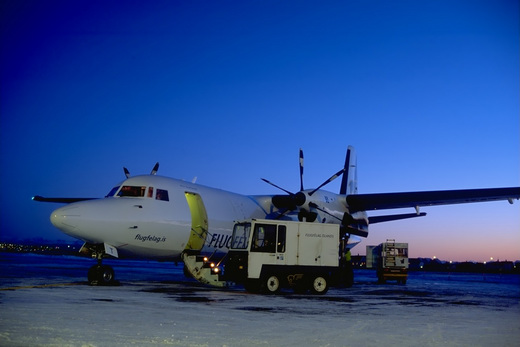 |
Reykjavik Airport |
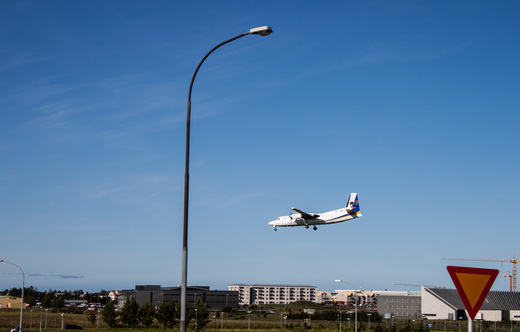 |
Reykjavik Airport |
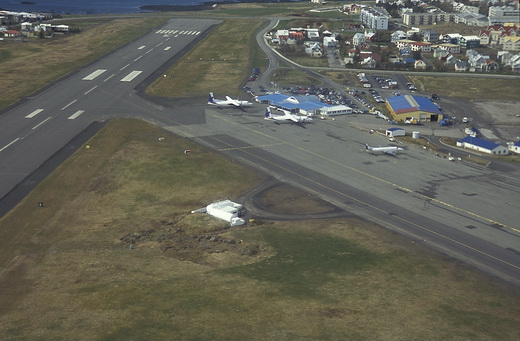 |
Reykjavik Airport |
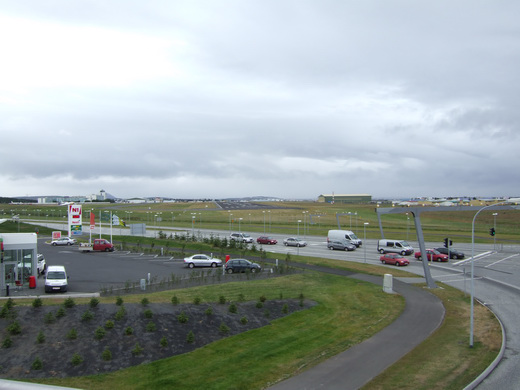 |
Reykjavik Airport |
Other facilities
Icelandair Group and Icelandair have a head office at the airport. Air Iceland and Isavia also have their head offices on the airport property. When Loftleiðir was in operation, its head office was at the airport.
Ground transportation
There are some local city buses at both terminal buildings.
BSÍ, located near the airport, 1.6 km (1.0 mi) from the main airport terminal, is a major bus terminal. At the bus terminal, Strætó bs provides bus service to areas around Reykjavik while Gray Line Iceland Excursions’ Airportexpress and Reykjavik Excursions Kynnisferðir’s Flybus services connect between Keflavík International Airportand Reykjavik Airport. When changing between domestic and international flights a 50 km bus transfer between Reykjavík Airport and Keflavík International Airport is usually needed, and at least three hours between flights is recommended.
Accidents and incidents
- On 27 December 1980, Douglas C-47B N54605 of Visionair International was damaged beyond repair in a storm at Reykjavik Airport.
Gallery
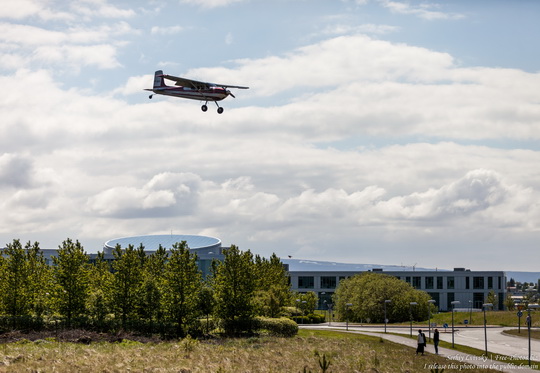
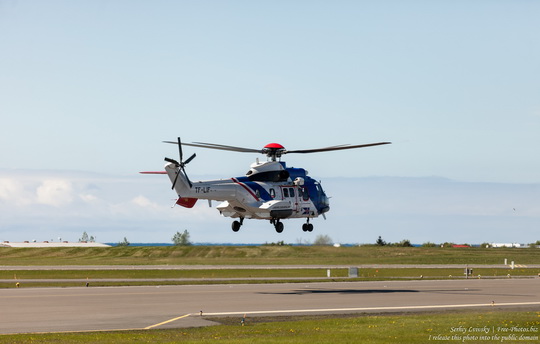
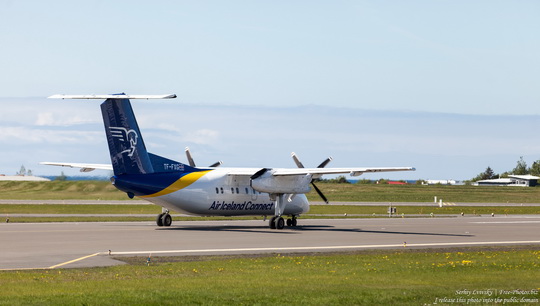
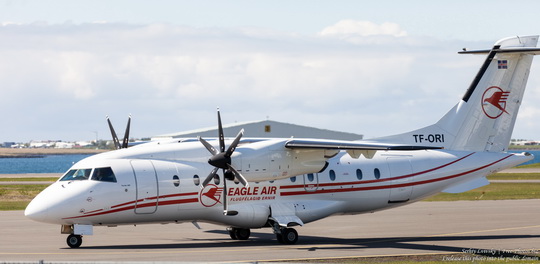
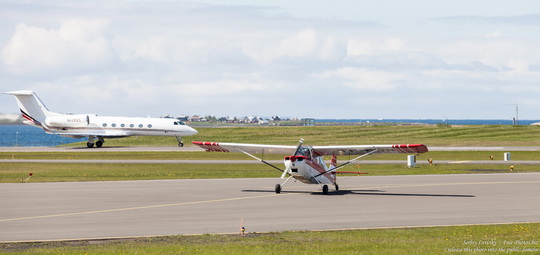
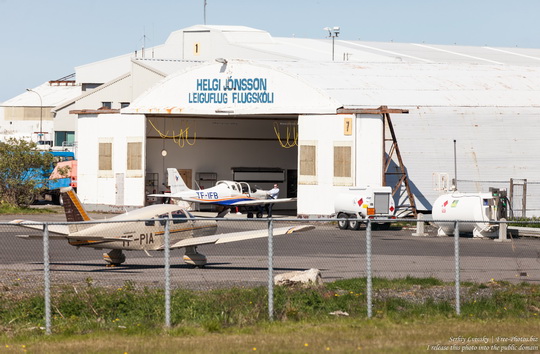
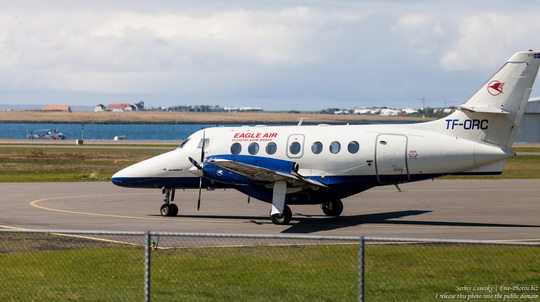
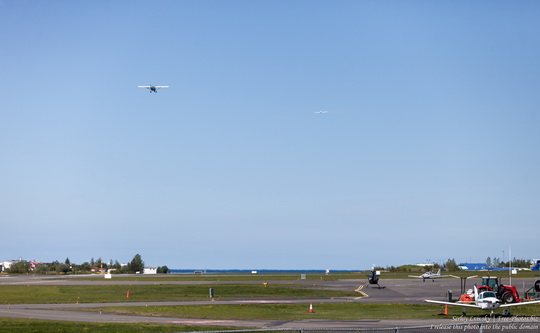
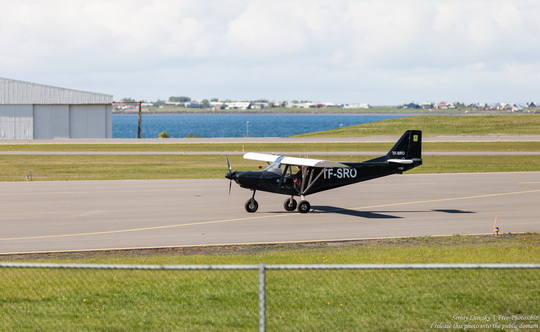
The above content comes from Wikipedia and is published under free licenses – click here to read more. Some of the above photos come from Free-Photos.biz.
| General
Info
|
| Country |
Iceland
|
| ICAO
ID |
BIRK
|
| Time |
UTC
0
|
| Latitude |
64.130000
64 07' 48.00" N
|
| Longitude |
-21.940556
021 56' 26.00" W
|
| Elevation |
48
feet
15 meters
|
| Type |
Civil
|
| Magnetic
Variation |
017 W (01/06)
|
| Beacon |
Yes
|
| Operating
Agency |
CIVIL
GOVERNMENT, (LANDING FEES AND DIPLOMATIC CLEARANCE MAY BE REQUIRED)
|
| Operating
Hours |
24
HOUR OPERATIONS |
| Communications
|
TWR
Opr H24. |
118.0
292.7
|
| RDO |
126.55
127.85
(126.55 E and S, 127.85 W)
|
| GND |
121.7
|
ATIS
Opr 0630-1900Z 1 Oct-31 Mar, 0630-2300Z 1 Apr-30 Sep. |
128.1
|
APP/DEP
Opr H24. |
119.0
|
| Runways
|
| ID |
Dimensions |
Surface |
PCN |
ILS
|
| 01/19
|
5141
x 148 feet
1567 x 45 meters |
ASPHALT |
028FAXT |
YES
|
| 06/24
|
3150
x 98 feet
960 x 30 meters |
ASPHALT |
028FAXT |
NO
|
| 13/31
|
4035
x 148 feet
1230 x 45 meters |
ASPHALT |
028FAXT |
YES
|
| Navaids
|
| Type |
ID |
Name |
Channel |
Freq |
Distance
From Field |
Bearing
From Navaid
|
| NDB |
SA |
SKAGI |
- |
379 |
10.6 NM |
194.1
|
| Supplies/Equipment
|
| Fuel |
Jet
A1, without icing nhibitor.
100/130 MIL Spec, low lead, aviation gasoline (BLUE)
|
| Other
Fluids |
OX,
Indicates oxygen servicing when type of servicing is unknown |
| Remarks
|
| CAUTION |
Bird
haz, large flocks at Rwy 01 thld. Numerous cranes in vcnty of
runways up to 257' MSL til 01 Feb 08.
|
| CSTMS/IMG |
Avbl.
|
| FLUID |
OX
avbl O/R
|
| FUEL |
Avbl
0700-2000Z (0700-2100Z sum), OT O/R via C354 840 3040. (NC-100LL,
A1)
|
| LGT |
PAPI
Rwy 01 GS 3.5 MEHT 50.23', PAPI Rwy 19 GS 3.5 MEHT 50.26', PAPI
Rwy 06 GS 3.5 MEHT 47.96', PAPI Rwy 24 GS 3.7 MEHT 51.97', PAPI
Rwy 13 GS 3 MEHT 50.87', PAPI Rwy 31 GS 3.7 MEHT 51.36'.
|
| MISC |
Ldg
fees.
|
| NS
ABTMT |
See
AP/2 Supplementary Arpt Rmk.
|
| RSTD |
Tkof
proh 2330-0700Z Mon-Fri, 2330-0800Z Sat-Sun exc for emerg flt.
Ngt ldg-reverse thrust shall be kept to min. |
The content above was published at Airports-Worldwide.com in 2020.
We don't guarantee the information is fresh and accurate. The data may be wrong or outdated.
For more up-to-date information please refer to other sources.
|
 |



